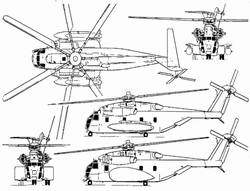And Then Some!
Sikorsky Aircraft tells ANN the latest testing on its 4th
generation rotor blade to the US Marine Corps has yielded better
than projected performance results.

The 4th Generation blade is the latest in a long chain of
innovations Sikorsky has made in the area of rotor systems. It
builds on the work done for Sikorsky's state-of-the-art Growth
Rotor Blade (GRB) currently used on the UH-60M and S/H-92
helicopter in a long chain of innovation in the area of rotor
systems.
The CH-53K model wind tunnel testing performed late this summer
has shown a significant improvement in forward flight efficiency
over the GRB. Earlier in the year, similar model rotor hover
testing indicated large gains in hover efficiency. Together, the
two tests further validate the large investments that Sikorsky has
made in 4th Generation blade aerodynamics.
 "This is tremendous
improvement in the rotor system," said Bob Moffitt,
Sikorsky's Manager of Flight Sciences and a 38-year veteran in
rotor system design. "The performance of the advanced blade
compared to our current technology translates directly into
increased payload range. For example, based on model rotor test
results, we expect range improvements of up to 90 nautical miles
over the GRB blade for similar S-92A applications. Also, for
certain hot-high conditions, the aircraft Max Cruise Speed will
increase from 135 knots to 146 knots."
"This is tremendous
improvement in the rotor system," said Bob Moffitt,
Sikorsky's Manager of Flight Sciences and a 38-year veteran in
rotor system design. "The performance of the advanced blade
compared to our current technology translates directly into
increased payload range. For example, based on model rotor test
results, we expect range improvements of up to 90 nautical miles
over the GRB blade for similar S-92A applications. Also, for
certain hot-high conditions, the aircraft Max Cruise Speed will
increase from 135 knots to 146 knots."
Currently used by the US Marine Corps, the three-engine Sikorsky
CH-53E Super Stallion helicopter is the largest, most powerful
marinized helicopter in the world. It is deployed from Marine Corps
amphibious assault ships to transport personnel and equipment, and
to carry external (sling) loads.
Sikorsky says the CH-53K will maintain virtually the same
footprint as the CH-53E, but will nearly double the payload to
27,000 pounds over 110 nautical miles under "hot high" ambient
conditions. The CH-53K's maximum gross weight will increase to
84,700 pounds versus 73,000 pounds for the CH-53E.
The upgrades slated for the CH-53K including the 4th Generation,
high-efficiency rotor blade are: joint interoperable glass cockpit
fly-by-wire flight controls; low-maintenance elastomeric rotorhead;
gross weight expansion; upgraded engine system; cargo rail locking
system; external cargo external cargo handling improvements and
survivability enhancements; and reduced operation and support
costs.
 This significant
improvement in technology and the efficiency of the rotor system is
also directly applicable to Sikorsky's HH-92 Superhawk, which it is
currently offering for the United States Air Force Combat Search
and Rescue Replacement (CSAR-X) program. A contract decision is
expected in November.
This significant
improvement in technology and the efficiency of the rotor system is
also directly applicable to Sikorsky's HH-92 Superhawk, which it is
currently offering for the United States Air Force Combat Search
and Rescue Replacement (CSAR-X) program. A contract decision is
expected in November.
"Our current S/H-92 blade flying on production aircraft today
more than satisfies the Air Force's Block 0 requirements. We are
very pleased that the 4th generation rotor blade technology that
will be integrated on the future Block 10 aircraft, is already
being proven today," said John Pacelli, Sikorsky's CSAR-X Senior
Business Acquisition Manager. "The successes achieved to date with
this technology will allow us to provide the Air Force with an even
more capable, and fully risk reduced solution to meet its future
mission needs."
Designed and built using rugged and proven BLACK HAWK
technology, the HH-92 advanced weapons system offers the best
combination of survivability, performance, interoperability, safety
and cost for the vital CSAR-X mission.
The Canadian government has contracted for 28 H-92 helicopters,
designated the CH-148 Cyclone, to conduct a variety of missions
including search and rescue, passenger and cargo transfer, medical
evacuations and tactical transport.
 ANN's Daily Aero-Linx (04.15.24)
ANN's Daily Aero-Linx (04.15.24) Classic Aero-TV: 'No Other Options' -- The Israeli Air Force's Danny Shapira
Classic Aero-TV: 'No Other Options' -- The Israeli Air Force's Danny Shapira Aero-News: Quote of the Day (04.15.24)
Aero-News: Quote of the Day (04.15.24) Airborne 04.16.24: RV Update, Affordable Flying Expo, Diamond Lil
Airborne 04.16.24: RV Update, Affordable Flying Expo, Diamond Lil ANN's Daily Aero-Term (04.16.24): Chart Supplement US
ANN's Daily Aero-Term (04.16.24): Chart Supplement US





